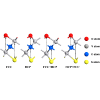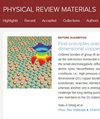Insight into Janus V2COS as anode material of high-performance alkali metal ion battery: Diffusion barrier, recyclability, specific capacity, and open-circuit voltage
IF 3.4
3区 材料科学
Q2 MATERIALS SCIENCE, MULTIDISCIPLINARY
引用次数: 0
Abstract
Transition metal carbides, nitrides, and carbonitrides, known as MXenes, exhibit exceptional conductivity, stability, and large specific surface area, rendering them promising candidates for anode materials in rechargeable batteries. Herein, we investigate the electrochemical characteristics of the Janus MXene monolayer, as an anode material of alkali metal ion batteries by using first-principles calculations. The phonon band structure and ab initio molecular dynamics simulations confirm the stability of the Janus monolayer. The mechanical and electrical properties of the Janus monolayer are explored and proved to have good mechanical stability and electrical conductivity. The surface of the Janus monolayer demonstrates the facile adsorption of alkali metal ions and low diffusion barriers. As an anode material, the recyclability of the Janus has been verified in the ion intercalation/deintercalation processes. Furthermore, the theoretical specific capacities and the open-circuit voltages of the Janus monolayer are calculated to be and 2.62 V for Li, and 0.76 V for Na, and and 0.4 V for K, respectively. It presents that the Janus monolayer is a potential anode material of sodium-ion batteries and potassium-ion batteries.

对 Janus V2COS 作为高性能碱金属离子电池负极材料的深入研究:扩散势垒、可回收性、比容量和开路电压
被称为 MXenes 的过渡金属碳化物、氮化物和碳氮化物具有优异的导电性、稳定性和大比表面积,因此有望成为充电电池的阳极材料。在此,我们通过第一原理计算研究了 Janus MXene V2COS 单层作为碱金属离子电池负极材料的电化学特性。声子能带结构和 ab initio 分子动力学模拟证实了 Janus V2COS 单层的稳定性。对 Janus V2COS 单层的机械和电气性能进行了研究,证明其具有良好的机械稳定性和导电性。Janus V2COS 单层表面易于吸附碱金属离子,扩散阻力低。作为阳极材料,Janus V2COS 的可回收性在离子插层/脱插过程中得到了验证。此外,计算得出 Janus V2COS 单层的理论比容量和开路电压分别为:锂 165.54mAh/g 和 2.62 V;纳 662.18mAh/g 和 0.76 V;钾 294.43mAh/g 和 0.4 V。这表明 Janus V2COS 单层是一种潜在的钠离子电池和钾离子电池阳极材料。
本文章由计算机程序翻译,如有差异,请以英文原文为准。
求助全文
约1分钟内获得全文
求助全文
来源期刊

Physical Review Materials
Physics and Astronomy-Physics and Astronomy (miscellaneous)
CiteScore
5.80
自引率
5.90%
发文量
611
期刊介绍:
Physical Review Materials is a new broad-scope international journal for the multidisciplinary community engaged in research on materials. It is intended to fill a gap in the family of existing Physical Review journals that publish materials research. This field has grown rapidly in recent years and is increasingly being carried out in a way that transcends conventional subject boundaries. The journal was created to provide a common publication and reference source to the expanding community of physicists, materials scientists, chemists, engineers, and researchers in related disciplines that carry out high-quality original research in materials. It will share the same commitment to the high quality expected of all APS publications.
 求助内容:
求助内容: 应助结果提醒方式:
应助结果提醒方式:


